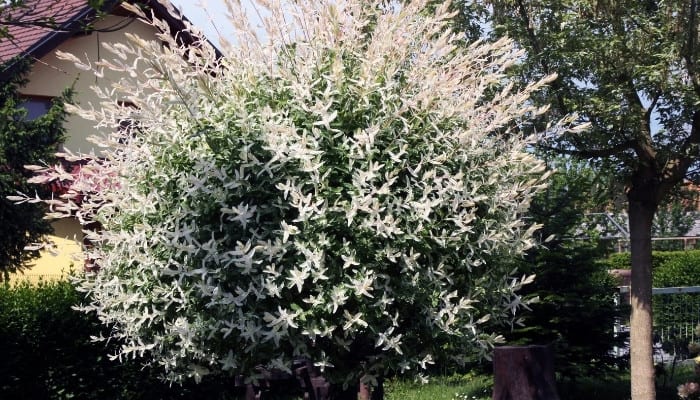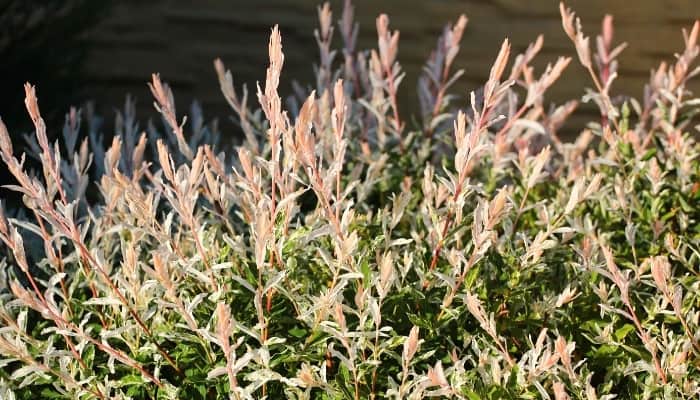If you are considering planting a dappled willow tree for the first time, you may be wondering if it is resistant to deer.
After all, we all know how hungry deer get, especially in the winter.
That said, if you are planting a new and tender sapling in your garden, you certainly don’t want to see it grazed to the ground as soon as it’s been planted.
Unfortunately, most plants, trees, and young saplings are on the menu for hungry deer.
However, knowing what preventative measures to take will stop your garden from turning into a snacking haven!
Is dappled willow deer resistant? Dappled willow is considered deer resistant. However, while deer prefer to graze on deciduous fruit trees and conifers, the soft bark of sapling dappled willow can be a great temptation. The subsequent bark damage can lead to disease caused by bacteria entering the bark and infecting the tree.
Protecting saplings such as dappled willow from deer damage can be a plant parents’ horticultural nightmare.
In the following you’ll discover how to protect your gorgeous dappled willow from becoming a tasty snack!
How To Protect Dappled Willow From Deer
As a savvy gardener, you may have considered whether your dappled willow is deer resistant, and you would be right in saying that it is. Problem solved, right? Unfortunately not.
Deer feed on a wide variety of plants and vegetation, especially if it is young and tender. As such, the tender bark of young dappled willow saplings presents a tasty treat, especially for deer in search of food.
In addition, deer tend to strip the bark from the tree, causing damage and allowing bacteria to enter and cause disease.
Nylon Netting/ Mesh Screen
Cut a suitably sized piece of nylon netting or mesh screen and drape this over your sapling. This will need to be anchored to the ground using garden twine attached to tent pegs.
(I used this netting on several of my plants, and it’s done the job well!)
Tree Wrap
This is excellent all-year-round protection and comes in paper, fabric, or plastic options (you can find it here). The wrap is wound around the sapling trunk, protecting the soft bark from deer scrapings or nibbling.
However, it does require replacing every three months to prevent insect infestation and moisture buildup.
Burlap
Use burlap sacks to cover your dappled willow during the wintertime. This will protect it from hungry deer and stop the tender branches from being damaged during heavy snowfall.
Wire Cage
Use a wire cage approximately 5-6 feet high and place it around the sapling, staking it down about 3 feet away from the tree.
While deer can jump much higher, they don’t tend to jump into small places where they may become trapped.
Tree Guards
These can be bought online (Amazon has them at a great price) and are round cylinders made from plastic netting mesh or vinyl. They easily wrap around the trunk of the sapling and can be cut to size.
However, you can make your own tree guards using chicken wire cut to size. Simply roll the chicken wire into a cylinder shape and wrap it around the sapling’s trunk, pushing it firmly into the ground.
Tree Protectors
Made from plastic tubing, this type of protection is excellent for slimmer trees.
First, measure the diameter of the trunk using a tape measure. Then purchase plastic tubing or pipe from the local hardware store.
Using a sharp pair of scissors, snip along the length of the tubing. This should allow you to wrap the tubing around the bark like a sleeve.
Dappled Willow Basic Care Guide

While easy to grow, the dappled willow requires a certain level of care to ensure vigorous, healthy growth.
Therefore, when planting a dappled willow, gardeners should be aware of its hardiness and growing requirements.
Planting Dappled Willow
The dappled willow thrives in USDA Zones 4-9 and enjoys the North and Midwest climate. Plant the sapling in full sun for vibrant leaf color; the more light it receives, the richer its leaf colors.
In addition, the soil pH should be mildly acidic, with a pH range of between 5.0 -7.0. Finally, ensure the soil is moist and drains well as the dappled willow does not enjoy boggy soil conditions.
Watering & Fertilizing Dappled Willow
Watering regularly during its first year of growth will ensure the dappled willow develops a healthy root system.
Once established and growing well, reduce the watering schedule but don’t allow the soil to become overly dry.
While you should avoid overwatering, watering regularly during the spring is beneficial to healthy growth.
Using a general-purpose fertilizer (I recommend this organic food), feed the dappled willow in the spring. This encourages improved health and vibrant leaf color.
Pruning Dappled Willow
Pruning should be done in the early spring. This removes dead or diseased foliage and branches and encourages new vigorous growth while maintaining the size and shape of the tree.
Remove approximately one-third of the branches to allow light and air to pass through. Old and diseased branches should be removed and discarded.
Then prune the remaining branches to the length you prefer; a healthy length is about 12 inches.
Related Questions:
Is Flamingo Dappled Willow Deer Resistant?
The Flamingo dappled willow is deer resistant. It belongs to the Salicaceae family and is a variety of willow tree similar in appearance to the standard dappled willow.
While deer tend to avoid feeding on this type of tree, they will feast on its foliage if food is scarce.
How Big Do Dappled Willow Bushes Get?
The dappled willow bush is a vigorous grower. It can reach 8-10 feet in height and 2-3 feet in width each year. However, regular pruning will maintain its shape and size.
Note that hard pruning every other year will keep this fast-growing beauty in check.
Conclusion
Often, the thought of pests, even that of the sizeable four-legged kind, only start to register once the damage has occurred.
However, with a bit of forward planning and careful maintenance, you can ensure that your dappled willow remains vibrant, healthy, and off the deer menu!

